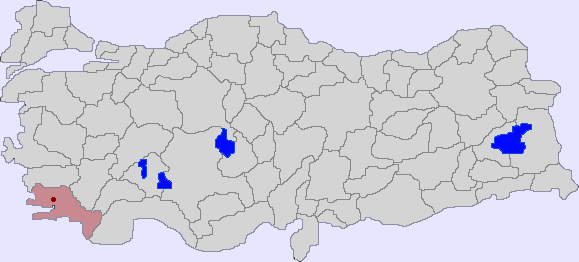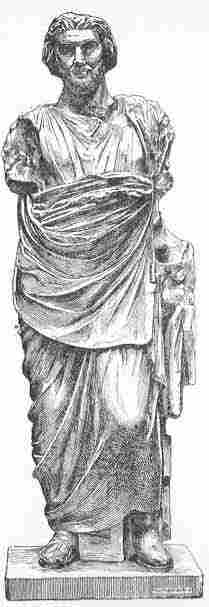.

Muğla Province
Milas (ancient Mylasa) is a city in southwestern Turkey. It is part of the province ('il') of Muğla, and administratively depends on the city of Muğla. It was the ancient capital of Caria and of the Anatolian Turkish Principality of Menteşe. The territory of Milas district boasts of 27 different archaeological sites, a record among local entities in Turkey, and probably anywhere.

The Temple of the Carian Zeus at the top of the Mount Hisar in Milas with a breathtaking view of the plain lying underneath (Source :Municipality of Milas).
In classical antiquity

Mausolus of Mylasa
Milas is situated on a fertile plain at the foot of mountain on which there are great quarries of the white marble which has been used for the construction or decoration of the city's temples and other buildings since antiquity.
Mylasa was taken by Labienus in the civil wars. In the Greco-Roman period it enjoyed a season of brilliant prosperity, and the three neighbouring towns of Olymos, Labraunda, and Euremos were included within its limits. Its finest temples were that dedicated to Zeus Osogoa, which recalled to Pausanias (VIII, x, 3) the Acropolis of Athens, and those of Zeus Karios and of Zeus Labraundos, or Stratios (Strabo, XIV, ii, 23). Mylasa is frequently mentioned by the ancient writers. At the time of Strabo the city boasted two remarkable orators, Euthydemos and Hybreas. Various inscriptions tell us that the Phrygian cults were represented here by the worship of Sabazios; the Egyptian, by that of Isis and Osiris. There was also a temple of Nemesis.
An inscription from Mylasa (first brought to light in Bulletin de correspondance hellénique, 1890, pp. 621-623) provided one of the few certain data about the life of Cornelius Tacitus, identifying him as governor of Asia between 112 and 113.
In the Christian era
Among the ancient bishops of Mylasa was St. Ephrem (fifth century), whose feast was kept on 23 January, and whose relics were venerated in neighbouring city of Leuke. Cyril and his successor, Paul, are mentioned by Nicephorus Callistus (Hist., eccl., XIV, 52) and in the Life of St. Xene. Le Quien mentions the names of three other bishops (Oriens christianus, I, 921), and since his time the inscriptions discovered refer to two others, one anonymous (C.I.G., 9271), the other named Basil, who built a church honour of St. Stephen (Bulletin de correspondance hellenique, XIV, 616). The St. Xene referred to above was a noble virgin of Rome who, to escape the marriage which her parents wished to force upon her, donned male attire, left her country, changed her name Eusebia to that of Xene (stranger), and lived first on the island of Cos, then at Mylasa.

Mausolus of Mylasa, in the area called Gümüşkesen (Source :Municipality of Milas).
Turkish era
Milas and the surrounding region has been taken over by the Turks of the Menteşe Principality in mid-13th century, who have established their capital in the city, the administrative center being the Beçin fortress at a distance of 5 km. from Milas and which was easier to defend. The fortress has been restored in 1974, and the compound includes two mosques, two medreses, a hamam, as well as the remains of a Byzantine chapel.
Milas, together with the entire Menteşe Principality has been taken over by the Ottoman Empire in 1390. However, just twelve years later, Tamerlane and his forces have beaten the Ottomans in the Battle of Ankara, and returned control of the region to its former rulers, the Menteşe Beys, as he did for other Anatolian Turkish Principalities. Milas was brought back under Ottoman control, this time by Sultan Mehmed II the Conqueror, in 1451.
At the turn of the 20th century, according to 1912 figures, Milas urban center had a population of 9000, in which some 2900 were Greeks, a thousand or so Jewish, and the remainder of the population, Turks. For the whole area covered by the county (kaza) of Milas, these figures were 28500 for the whole population, 21000 of which were Turkish and 3500 to 7000 according to varying sources were Greeks. Milas Greeks have been exchanged with Turks living in Greece under the 1923 agreement for Exchange of Greek and Turkish Populations between the two countries, while the sizable Jewish community remained as a presence till the 1950's, at which time they emigrated to Israel, still visiting Milas frequently to this day.
Features and sights of interest
The Cyclopean walls surrounding the sacred enclosure of the temple of Zeus Osogoa (called Zeus Carios, the Carian Zeus) are still visible, as well as a row of fourteen columns.
The 18th century English traveller Richard Pococke relates, in his Travels, having seen the temple of Augustus of Rome, the materials of which have since partially been taken by the Turks to build a mosque.
There is also a two storied tomb, called Distega, apparently a copy of the famous tomb of Mausolus in Halikarnassos, who was native of Mylasa.
There are a number of historical Turkish buildings in Milas, dating from both the Menteşe and the Ottoman periods.
Milas rugs woven of wool are internationally famous since more than 200 years and bear typical features. In our day, they are no longer produced in the city of Milas, but rather in a dozen villages around Milas. For the whole territory of Milas district, up to 7000 weaver's looms remain in activity, full-time or at intervals following the demand trends, which remain quite lively both inside and from outside Turkey.
Sources
This article incorporates text from the public domain Catholic Encyclopedia.
S. Anagiostopoulou (1997) and G. Sotiriadis (1918) for the demographic data
Links
| Ancient Greece
Science, Technology , Medicine , Warfare, , Biographies , Life , Cities/Places/Maps , Arts , Literature , Philosophy ,Olympics, Mythology , History , Images Medieval Greece / Byzantine Empire Science, Technology, Arts, , Warfare , Literature, Biographies, Icons, History Modern Greece Cities, Islands, Regions, Fauna/Flora ,Biographies , History , Warfare, Science/Technology, Literature, Music , Arts , Film/Actors , Sport , Fashion --- |
Retrieved from "http://en.wikipedia.org/"
All text is available under the terms of the GNU Free Documentation License


